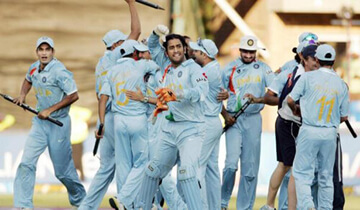Test cricket is the oldest and most prestigious format of the game of cricket. With a history stretching back to 1877, test matches are played over 5 days between two teams of 11 players each and consist of 4 innings in total.
The Slow Burn of Test Cricket
Test cricket is often called the ‘purest’ form of the game and exemplifies the quintessential aspects of cricket - patience, strategy, skill and endurance. Unlike the faster formats like T20 and ODIs, the languid tempo of test cricket allows for ebbs and flows as the game unfolds over 5 days.
This elongated duration allows for greater in-match strategizing, unpredictability and comebacks not possible in limited over cricket. The gradual shifts in momentum, prolonged build-up of nail-biting suspense and eventual euphoric upheavals are unique to test cricket.
The Ultimate Test of Skill and Temperament
Given the extended game time, tests are the ultimate examination of cricketing skills and temperament. With ample time, batsmen can construct larger innings by pacing their aggression and defense. Meanwhile, bowlers have more opportunities to take wickets through sustained high-quality bowling while constantly varying their strategies.
The additional psychological pressure of test cricket also separates the wheat from the chaff - mastery over self-discipline, resilience and concentration become prerequisites alongside technical excellence. Ultimately, test cricket provides the most authentic platform for players to etch their names in the pantheon of cricketing greats.
The Pinnacle for Cricket Purists
While the shorter T20 format has attracted new audiences with its big hits and faster pace, test cricket remains the pinnacle for cricket purists. The nuanced ebbs and flows of test cricket, filled with subtle strategies, protracted tensions and nail-biting climaxes, provide unparalleled intrigue and satisfaction for connoisseurs.
Test cricket’s emphasis on patience, technique and grit provides a welcome respite from modern life’s impatience. For cricket romantics, the longer format retains an enduring magic and prestige that cannot be replicated elsewhere. Test cricket is set to thrive as the supreme examination of playing ability and strategic thinking.
One common question that arises is “what does ICC stand for in cricket?” The ICC, or the International Cricket Council, is the global governing body of cricket. It’s responsible for the organization and governance of cricket’s major international tournaments, including the Cricket World Cup.
The Intricacies of Time Management in Test Cricket
Test cricket is the longest and most prestigious format of the game of cricket. While limited overs cricket like One Day Internationals and Twenty20 matches have time limits on innings, test cricket has no limits on the number of overs in an innings. Teams bat until their innings is completed through reaching a declaration or being bowled out. This open-ended nature of test innings requires careful management of time by the officials to ensure matches progress fairly for both teams.
Overs Per Day
A major consideration for time management is the target number of overs to be bowled each day. The standard target is 90 overs per day, bowled over three sessions of two hours each with designated lunch and tea breaks. The two hour sessions mean fast bowlers are generally limited to bowling spells of around 20 overs before needing a break, usually lasting an hour before bowling again.
Umpires make decisions before the start of each day’s play on the minimum number of overs to be bowled, factoring in time lost to weather interruptions or other delays. Their goal is to squeeze in as close to the 90 over target as possible, while allowing for contingencies. If time is lost, it can be made up by adding extra playing time of up to 30 minutes per day.
The minimum overs required also reduces if wickets fall quickly or time is wasted between overs. So the umpires have the flexibility to demand fewer overs while still keeping the match moving.
Last Hour of Match
Specific rules apply to the last hour of a test match to prevent time wasting tactics. The last hour must contain a minimum of 15 overs bowled, implying a maximum of 16 minutes per over on average. This ensures both teams get a fair chance to push for a result at the climax of the match.
If any time is lost in the last hour due to weather or other interruptions, that time is added on to the playing time. So a minimum of 15 overs will be bowled in the last hour, extended as needed to make up for lost time.
Use of Splits
An alternate structure sometimes adopted is the use of ‘splits’ of 30 overs between breaks of 35 minutes. This format does away with the designated lunch and tea breaks, instead providing more frequent shorter breaks. The intention is to provide extra flexibility in making up overs lost to inclement weather.
The split format also reduces the strain on fast bowlers by limiting their spells to 30 overs rather than 2 hours. This can allow faster over rates when quick bowlers are operating, while still providing them adequate rest. However, the traditional session format remains the most prevalent.
Slow Over Rates
A perennial issue in test cricket is slow over rates by the fielding team. Without the governing umpires taking charge to demand adequate over rates, matches would progress at a snail’s pace.
Fines and other sanctions for slow over rates have been introduced by the ICC to deter time wasting. But umpires still play a key role in cajoling captains to keep the game moving through firm warnings and intervention when needed.
Weather Delays
Inclement weather is an ever-present threat to scheduled play in test cricket. Rain breaks and poor visibility can lead to lengthy delays and loss of overs. The umpires have the unenviable task of inspecting conditions and deciding when play can safely resume.
Making up lost overs is a balancing act. Umpires have to consider adding extra time without overburdening the players. Careful judgment is required on whether to continue into the evening or extend next day’s play.
Importance of Pace of Play
Ultimately, time management in test cricket is all about ensuring the scheduled overs are actually bowled each day. The officials balance maximizing playing time against the need to provide breaks for meals, drinks and rest. But within those constraints, they prioritize keeping the game moving by bowling the required minimum overs.
This pragmatic approach to time management maintains the special appeal of test cricket - the unhurried style of play rewarding patience and perseverance. Careful scheduling allows drama to unfold gradually over five days, the hallmark of cricket’s most prestigious format.
Conclusion
Test cricket’s unique open-ended structure and five-day duration necessitates intricate management of time by officials to ensure fair play. The target of 90 overs per day provides guidance, but flexibility is required accounting for delays and game situations. Umpires must balance maximizing play each day with adequate breaks for players. Specific rules for minimum overs in the climactic last hour prevent time wasting tactics from depriving a chance for victory. Slow over rates have become an issue, requiring firmer policing. Rain disruptions are an ever-present challenge, with umpires needing good judgment on when to resume play and make up lost overs. Ultimately, pragmatic time management maintains test cricket’s essence - steadily building intrigue through unhurried play rewarding patience. The careful scheduling creates the stage for gripping drama to unfold over five days. Test cricket’s unique allure stems from this intricate structure; an examination of skill and endurance founded on meticulous, adaptable time management by officials. This ensures the purest format of cricket maintains its prestige as the supreme test of playing ability.







































